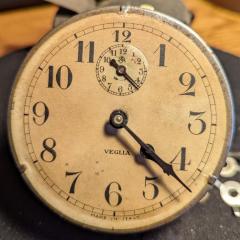Case back seals
-
Recently Browsing
- No registered users viewing this page.
-
Topics
-
Posts
-
Hello everyone, this will be my first proper walkthrough and also my most complicated watch yet. A beautiful JLC Memovox E875 ("Speed beat") with calibre 916. This is the first of several posts: disassembly. You'll see my order of disassembly and close-ups of all the screws. Those are the main points. If there's anything particular, I'll write a comment. Otherwise the pictures are hopefully self-explanatory. Here's the beauty before disassembly: Ready to go with nicely dressed tweezers... also, screw slots are generally very thin so I also dressed all screwdrivers to very fine tips. inside of the caseback has a little knob that is hit by a hammer to create the alarm sound. Movement complete. before any disassembly, you can already see the magic level system of the automatic works I start by taking off the rotor. rotor underside rest of automatic works with three blued screws. magic lever system balance first.. identical stems. two case screws retention ring holds the gasket hands off and some dial-porn dial feet screws are nicely positioned so you can hold the movement in one position and access both at the same time. Thanks, JLC! both dials off let power down before this point! driving wheel for ratchet wheel / kinda-reversing wheel the alarm system train bridge I take the opportunity to remove the clutch wheelS and sliding pinionS. Again, both are identical. Nice. back to the train barrel can come out without damaging the center wheel. But careful. underside of the bridge with TWO crown wheels. NOTE: one "seat" is missing. Its absence has cause some damage to the bridge. I had indeed felt some resistance when winding the alarm barrel and it was one reason why I wanted to service it.. Part 414 is ordered from eBay. Barrel says "do not open". A whole other thread is devoted to this, see here: let's do the dial side: this spring was hard to get out. only an oiler would squeeze under it. the date wheel can stay assembled like this (no disassembly shown in the manual) previous watchmaker liked oil a lot. the alarm activation wheels lots of wheels.. also part of the alarm system pretty cool how the two keyless works are kind of the same and with some overarching parts damn, this spring was hard to get out. canon pinon and then the center wheel i remove balance jewels on both sides for thorough cleaning and reinstall the balance for cleaning. alarm barrel is normal (no "do not open"). the main barrel takes some nerves to open, but does so just fine. However, the edge of the barrel (where it holds the lid) is burnished a bit. I'm smoothing it out with the pointy end of a bracelet tool. This will allow the lid to go back in without problems. I'm planning on burnishing it over again when the new mainspring is installed. work in progres. done
-
Hello everyone, I hope you're all doing well. I'm currently searching for a used, most likely will be vintage, watch cleaning machine locally. Any advice on what to look for in such a machine would be greatly appreciated. I recently came across an Elma Record Watch Cleaning Machine being sold by a seller [picture attached], but it appears to be in rough condition. Initially, I was interested in it for the motor, which reportedly works. However, the seller mentioned that scrap dealers were offering more, and after a brief negotiation, he stopped communication and blocked me lol. Interestingly, the seller later relisted it at a lower price than what I had offered ($10 equivalent). I appreciate everyone's input and tips, thank you!
-
By nevenbekriev · Posted
Hi Rich, I doubt that it is epilame, as USSR watchmakers (those who repaired watches) usually newer heard of such thing existing. It is not for sure powder from worn stone, Rather something that the movement was exposed when the cover was open. -
By watchweasol · Posted
Hi Hector. Never have I seen anything like that. Other t an tht it looks a nice clock from the outside pitty the movement is in poor shape -
Will you be kind and show the balance complete? Is it a flat spring or overcoil ? Rgds
-



.thumb.jpg.cb17a66989f1e796fd4217db2e9ca9df.jpg)



Recommended Posts
Join the conversation
You can post now and register later. If you have an account, sign in now to post with your account.
Note: Your post will require moderator approval before it will be visible.